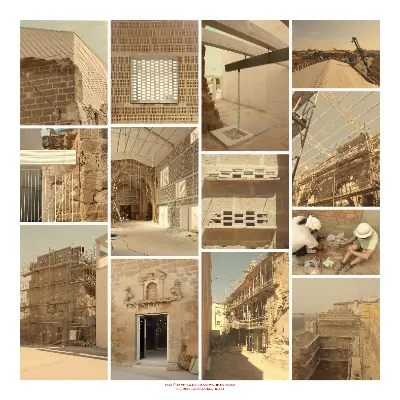比拉诺瓦德拉巴尔卡古教堂

下载所需积分: 2
维拉诺瓦·德·拉·巴尔卡古教堂 “西班牙莱里达” 是一座13世纪的哥特式建筑,因西班牙内战期间的轰炸于1936年部分被拆除。从那时起,教堂一直处于普遍的废墟状态,仅保留了其后殿、一些船身的碎片和西立面。该项目的主要目标是恢复古教堂的遗迹,并恢复其原始外观,同时将旧结构转变为一个新的多功能大厅。该项目旨在建立旧部分与新元素之间、过去与现在之间的建筑对话。
原始教堂的平面图为巴西利卡式,设有两个船身、一个祭坛和侧小教堂。建筑长22米,宽7米,内部空间高达10米。在东方部分,幸存的建筑保留了两个令人印象深刻的侧拱,可能源于罗曼式风格,以及一个17世纪晚期哥特式风格的肋拱在后殿。整座教堂是用当地的石材砌成的,但由于气候条件和时间的侵蚀,受到了很大损坏。更近一些,教堂还受到了一座附属单户住宅的建设的严重影响,该住宅位于原来的墓地上。
项目中最重要的部分集中在覆盖元素上:立面和屋顶。该项目建立了一个新的砖砌立面,基于格子纹理,并采用新的山形阿拉伯瓦屋顶。整个系统被构思为一个新的建筑陶瓷外壳,轻轻支撑在古老墙体的遗迹上。外立面呈现出密闭和不透明的状态,没有窗户,作为一个纹理背景,重现了古教堂石材的皱褶、密集和不规则的纹理,倡导与原有结构的视觉连续性和融合。另一方面,内立面则采用白色穿孔砖,增强了旧部分与新元素之间的对比和不连续性。从外部看,古教堂的形象得以恢复,而在内部,建筑保留了原始神圣空间的宁静和内省氛围。
该项目通过改造原墓地区域提供了建筑的新入口,这一空间位于教堂与附属单户住宅之间。该项目取代了后殿的原入口——在教堂拆除后引入的奇怪门口——并将这一空间转变为一个新的入口庭院,经过多年的压抑后,赋予这一区域新的尊严,因其被大型相邻隔墙所压制。凉棚、树木、地被植物和水链构成了一个新的场景,为教堂内部提供了一个入口阈。
The Ancient Church of Vilanova de la Barca (Lleida, Spain) is a 13th century Gothic building that was partially demolished in 1936 as a result of the bombings during the Spanish Civil War. Since then, the church had been in a general state of ruin, preserving just its apse, some fragments of the naves and the west façade. The main aim of the project was to recover the rests of the ancient church and to restore its original appearance while transforming the old structure in a new multi-purpose hall. The project aims to establish an architectural dialogue between the old parts and the new elements, between the past and the present.
The original church has a basilica-styled floor plan with two naves, a presbytery and lateral chapels. The building is 22 meters long and 7 meters wide, with an interior space rising up to 10 meters. In the oriental part, the surviving construction preserved two impressive lateral buttresses, probably of a Romanesque origin, and a ribbed vault of the 17th century in a late Gothic style in the apse. The entire church was built with a stone ashlar of the area which was largely damaged by the weather conditions and the erosion of time. More recently, the church has been severely affected by the construction of an attached single family house in the former graveyard.
The most important part of the project has focused on the covering elements: the façade and the roof. The project establishes a new brick façade based on a latticework texture and a new gabled Arab tile roof. The entire system is conceived as a new architectural ceramic shell that is gently supported over the remains of the ancient walls. The outer façade rises hermetic and opaque, with no windows, as a textured background that reproduces the wrinkled, dense and irregular texture of the stone ashlars of the ancient church, advocating for a visual continuity and integration with the original fabric. On the other hand, the inner façade is designed with a white perforated brick which reinforces the contrast and discontinuity between the old parts and the new elements. From the outside, the perception of the old church is restored, whereas in the inside, the building preserves the atmosphere of rest and introspection of the original sacred space.
The project offers a new alternative entrance to the building through the transformation of the area of the former graveyard, an adjacent space located between the church and the attached single family house. The project replaces the former access of the apse —a bizarre door introduced after the demolition of the church— and transforms this space into a new entrance patio, dignifying this area after years of being suffocated by the large adjacent dividing wall. The pergola, the trees, the carpeting vegetation and the water chain draw a new scenography that serves as an entrance threshold to the church’s interior.